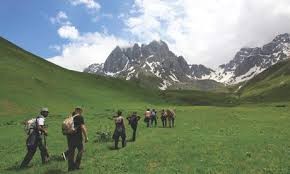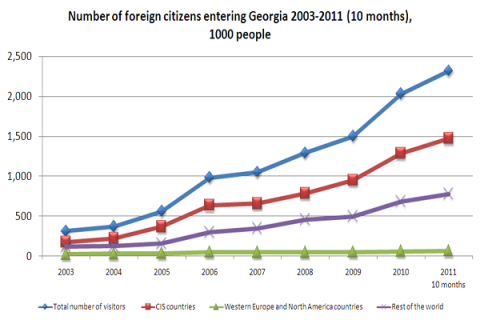Judging by the number of foreigners entering Georgia since 2004, tourism expanded at a breathtaking average pace of 32% a year, nearly doubling every three years. A simple extrapolation suggests that in four more years, by 2015, Georgia may be receiving more than 5mln tourists per year. Is this a realistic estimate? Would it be a blessing or a curse (in disguise)?
The growth in the number of visitors far outstripped the pace of investment in the tourism infrastructure, driving prices up and negatively affecting the quality of services. Thus, the main causal explanation for such a spectacular growth is the country’s new image as a top economic reformer, an island of democracy; exotic, under explored and yet a secure location with good food and wine, relatively close to home. So far, tourists have been willing to pay a significant price premium to satisfy their curiosity for this Near Eastern outpost of Western civilization.
There are reasons however, to be skeptical about mass tourism as a driver of long-term economic development in Georgia.
- First, the growth in tourism may be hard to sustain due to price and quality competition with Turkey and the need to sustain current levels of investment in infrastructure for many years to come.
- Second, whether successful or not, the effort to promote mass tourism runs the risk of straining the fragile environment and destroying unique ecosystems.
- Finally, there are purely economic considerations to bear in mind.
Unfortunately, tourism – like many other labor intensive service industries – has little potential for substantial productivity growth: it takes about the same amount of labor to cook one Imeretian khachapuri today as it did in the 19th century. As wages are typically tied to productivity this also means that tourism in and of itself has little potential for income growth. Wages in tourism may eventually increase – a phenomenon known to economists as “Baumol’s cost disease” – when other sectors improve their productivity and start competing for workers with the tourism industry.
Thus, if the Georgian government decides to continue to invest in tourism it should be advised to worry not about the sheer number of tourists but rather about the amount of money they spend in the country. According to this view, Georgia should strive to increase the share of relatively wealthy tourists from Western Europe and North America who account for a meager 3.6% of total border crossings by foreigners in the first 10 months of 2011. Of particular importance would be to increase the number of tourists visiting the country in the offseason period. This would help attract additional investment in human and physical capital, bringing the quality of services to a level appropriate for high-end tourism.
A shift to high-end tourism would help boost incomes and productivity. And it is this factor – how productive we are – that will ultimately define the quality of life in Georgia.

















Comments
I agree that a growing tourism industry can be a mixed blessing for a country. Along with the pitfalls outlined in the blog, the danger associated with becoming just another “Disneyland” of mass tourism is in losing the very reason why people would want to come to Georgia, as well as losing a part of the national identity.
The magnificence of Georgian landscapes is in the wild, untamed nature of their beauty. It is also one of the very few places in Europe where one can still witness and appreciate the tenacity and courage of people who do not merely survive, but "live with" the land, with the nature that is both generous and unforgiving.
Of course we almost always accept as inevitable the sacrifice of “tradition” for “progress”. Most of the time, it is difficult to tell whether the changes we are going through are for better or for worse. However, I do believe that depends to a large degree on what people perceive to be at the “core” of their identity. And my feeling is that Georgians, as a people have been formed to a great extent by the freedom, the wilderness, and the power of their mountains.
Any successful and smart approach to developing a tourism industry would take into consideration these important cultural aspects.
Bravo stardust! Some parts of Georgia have been for centuries defined by their remoteness and isolation. Svaneti, for example, was able to preserve its unique lifestyle and architecture because it has never been conquered by a foreign invader. The current plans to transform Svaneti into a "Switzerland of the Caucasus" are suggestive of a "character assassination" attempt. A lot of "progress" at the expense of tradition.
Another illustration of what's going on is Nekresi - once a difficult-to-reach ancient monastery complex on a hill overlooking the Alazani valley: gorgeous, mystic and inspiring. Well, not any more. Restaurants, picnic tables, thick smoke and smells of barbecue at the bottom of the hill. Marshrutka buses running up and down the new road to the monastery, dozens of people -- members of the "Occupy Nekresi" movement, elbowing their way through...